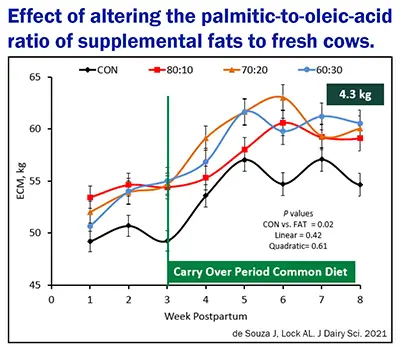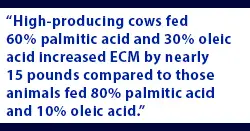
Fatty acid feeding strategies in a high-cost market
 By Marin Western
By Marin Western
It’s no surprise to anyone that supplemental fat prices have followed all other feed prices and continue to jump. Consultants and producers are constantly looking for ways to decrease feed costs, calling fat into question on many operations.
Recent research has taught us to focus on individual fatty acids and target ratios to specific groups of cows. We can target specific groups, save some money where possible and limit potential loss caused by eliminating fat from all diets. The ultimate question then becomes: Who gets the fat I am willing to buy?
Here’s how I rank importance of supplementation:
1. Fresh cows
In one recent study (de Souza and Lock, 2021), animals fed a ratio of 60% palmitic acid and 30% oleic acid increased dry matter intake and energy-corrected milk (ECM), and did not lose as much body condition as cows fed a greater proportion (80%) of palmitic acid. After 21 days, all cows were fed a common diet with no additional fat for another five weeks. Researchers observed animals fed fat in the first 21 days had a carryover effect and produced nearly 10 pounds more ECM than animals not fed fat in the fresh period.

 2. High-producing cows (greater than 110 pounds of milk)
2. High-producing cows (greater than 110 pounds of milk)
In a separate study, high-producing cows fed 60% palmitic acid and 30% oleic acid increased ECM by nearly 15 pounds compared to those animals fed 80% palmitic acid and 10% oleic acid (de Souza and Lock, 2017). If the previously mentioned study showed a carryover effect from feeding a 60:30 ratio to fresh cows, why feed supplemental fat to any groups other than the fresh cows?An abstract from ADSA in 2020 by Pineda and Lock showed an additional increase in ECM when cows were fed 60% palmitic acid and 30% oleic acid.
3. Maintenance cows (less than 110 pounds of milk)
A study published in 2020 (Western and Lock) showed lower-producing cows responded better to a blend containing 80% palmitic acid and 10% oleic acid compared to 60% palmitic acid and 30% oleic acid. ECM in the 80:10 treatment group was almost 5 pounds higher than the 60:30 group. Research also shows us that animals fed this blend do not gain as much body condition, which is important in later lactation.
4. Other groups
If a farm does not split cows into the above groups (perhaps it has a one-group TMR), the best option we have found is a 70% palmitic acid and 20% oleic acid blend, which is between the two previously mentioned ratios. Although we miss some opportunity on ECM with the high-producing cows, it is the best compromise to feeding all stages of lactation and production levels.
Before pulling fatty acid supplementation away from animals, analyze the value supplemental fat brings to the table. If you are not utilizing these fatty acid blends, now would be a great time to implement and track responses in these groups. Although expensive, fatty acid supplementation is a safe way to add energy and help maximize ECM, therefore increasing profitability.
About the author: Marin Western is a Vita Plus dairy specialist in central Michigan. She earned her bachelor’s degree in animal science and agribusiness management at Michigan State University. She continued there to earn her master’s degree in dairy nutrition through the Vita Plus Dairy Nutrition and Management Fellowship. Part of her fellowship research focused on dairy cow production responses to different fat supplements. As an undergraduate student, Western worked at a Vita Plus intern and performed research focused on the critical analysis of bacteria and various spoilage agents in forages.
| Category: |
Dairy Performance Feed additives Feed quality and nutrition Milk production and components |

